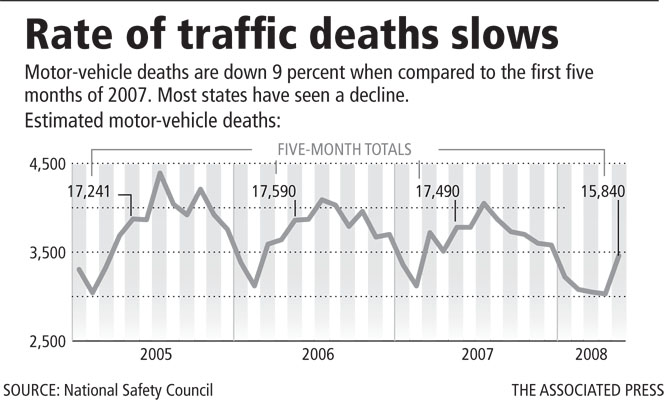Traffic deaths driven down

COLUMBUS, Ohio — Rising gasoline prices appear to be having at least one positive effect: Traffic deaths around the country are plummeting, just as they did during the Arab oil embargo three decades ago.
Researchers with the National Safety Council report a 9 percent drop in motor vehicle deaths through May compared with the first five months of 2007, including a drop of 18 percent in March and 14 percent in April.
Some states have reported declines of 20 percent or more. Thirty-one states have seen declines of at least 10 percent, and eight states have reported an increase.
No one can say definitively why fatalities are falling, but it is happening as Americans cut back on driving because of record gasoline prices.
Officials with two of the three largest law enforcement agencies in Southern Nevada said Tuesday the first five months of 2008 showed significant drops in fatalities compared with the same period in 2007. But those officials weren’t sure how much of a role higher gasoline prices played in those reductions.
“It might be a factor, but it’s not the factor,” said Kevin Honea, a spokesman with the Nevada Highway Patrol. Through May, the agency reported 34 fatalities, down from 35 in 2007 during that time.
Honea said the agency has seen a three-year decline in auto fatalities.
He attributed the drop more to people wearing seat belts and more officers being on the road because the agency received federal grants that paid for the officers’ overtime. During the past three years, the agency reported slightly fewer than 100 fatalities per year, he said.
For the Metropolitan Police Department, the largest police agency in Nevada, the number of car fatalities through May 24 was 50, down from 78 through May 2007.
Las Vegas police are on a pace to reduce fatalities for a fifth straight year. In 2007, the agency reported 132 fatalities.
Spokesman Keith Paul said the Henderson Police Department also has seen a decline in fatalities from a year ago. Through May, Henderson police reported seven fatalities compared with 16 through May 2007.
Paul, like Honea, attributed the reduction to beefed-up enforcement by more officers on Silver State roads.
“It’s hard for us to say why the numbers went up and down,” Paul said. “Officers on the street serve as a deterrent for motorists to drive the way they should be.”
Henderson had 25 fatalities in 2007, far more than the eight fatalities in 2006 and 11 in 2005.
Fewer people on the road means fewer fatalities, said Gus Williams, 52, of Albany, Ga., who frequently drives to northern Ohio. “That shows a good thing coming out of this crisis.”
He also has noticed many motorists going slower.
The government reported in April that miles traveled fell 1.8 percent in April compared with a year earlier, continuing a trend that began in November.
Experts say a slumping economy and fuel prices have brought down the number of road fatalities in a hurry.
“When the economy is in the tank and fuel prices are high, you typically see a decline in miles driven and traffic deaths,” said John Ulczycki, the council’s executive director for transportation safety.
States also cite factors such as police stepping up their pursuit of speeders and drunken drivers, as well as better teen-licensing programs, safer vehicles and winter weather that kept many drivers at home.
The Governors Highway Safety Association also says seat belt use is probably at record levels and will top 90 percent in several states when figures are released later this year.
But the last time road deaths fell this fast and this sharply was during the Arab oil embargo in 1973-74, when fatalities tumbled 17 percent, from about 55,100 to 46,000; and as states raised the drinking age to 21 in 1982-83, when fatalities fell 11 percent, from roughly 49,300 to 44,000.
Chuck Hurley, a former official with the National Safety Council and the Insurance Institute for Highway Safety, said half the decline in road deaths during the 1970s was attributed to high gasoline prices. The remainder was linked to the lowering of freeway speed limits to 55 mph.
Republican Sen. John Warner of Virginia has said Congress might want to consider reimposing a national speed limit.
Hurley, now chief executive of Mothers Against Drunk Driving, said gasoline prices have helped curb drunken driving, too.
Even considering new safety measures by states, it’s clear that, just like in the 1970s, motorists are cutting discretionary travel and reducing the kind of late-night outings for alcohol that lead to deadly accidents, Hurley said.